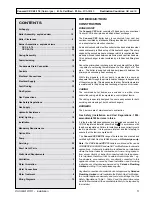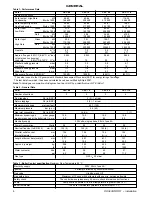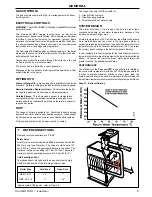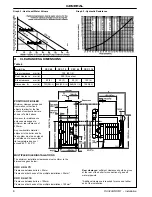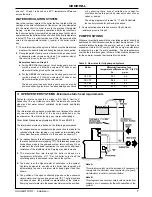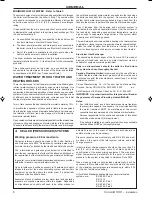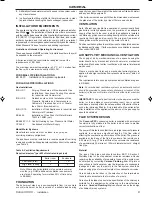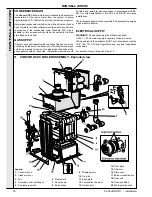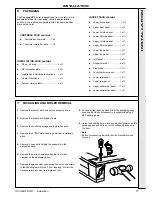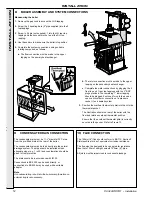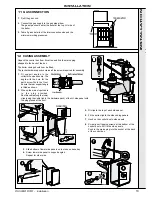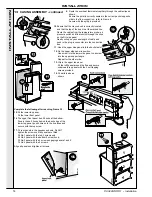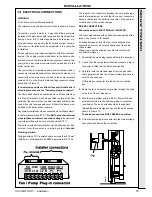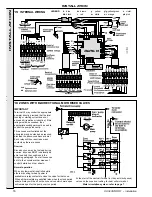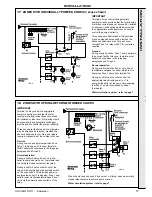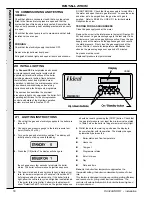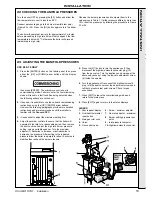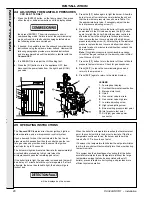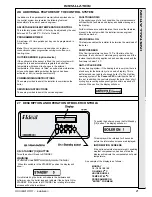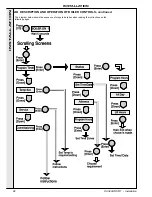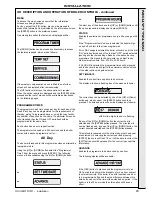
8
Concord CXC -
Installation
4
SEALED (PRESSURISED) SYSTEMS
automatic reset. In the event of shut down both visual and
audible alarms may be necessary.
Pressure vessels used must comply with BS. 4814 and must
be sized on the basis of the total system volume and initial
charge pressure.
Initial minimum charge pressure should not be less than 0.5
bar (7.2 psi) and must take account of static head and
specification of the pressurising equipment. The maximum
water temperatures permissible at the point of minimum
pressure in the system is specified in Guidance Note PM5.
When make up water is not provided automatically it will be
necessary to fit controls which shut down the plant in the event
of the maximum system pressure approaching to within 0.35
bar (5 psi) of safety valve setting.
Other British Standards applicable to commercial sealed
systems are:-
BS. 6880: Part 2.
BS. 1212
BS. 6281: Part 1
BS. 6282: Part 1
BS. 6283: Part 4
GENERAL
the cold feed pipe that system water expands into the tank when
the boiler passes heat into the system. Conversely, when the
system cools, water previously expelled is drawn back from the
tank into the system, together with a quantity of dissolved oxygen.
Even if leakage from the heating and hot water system is
eliminated there will be evaporation losses from the surface of
the tank which, depending upon ambient temperature, may be
high enough to evaporate a large portion of the system water
capacity over a full heating season.
There will always be corrosion within a heating or hot water system
to a greater or lesser degree, irrespective of water characteristics,
unless the initial fill water from the mains is treated. Even the
water in closed systems will promote corrosion unless treated.
Aluminium Heat Exchanger
The secondary heat exchanger of the Concord CXC is made of
aluminium finned tube and so any water treatment must be
suitable for systems containing aluminium.
Under
no
circumstances should the boiler be fired
before
the system has been thoroughly flushed.
Caradon Plumbing Limited
recommend only the use of Fernox
or Betz Dearborn water treatment products, which must be used
in accordance with the manufacturers instructions. For further
information contact :-
Fernox Manufacturing. Co. Ltd, Tandem House, Marlowe Way,
Croydon, Surrey CRO 4XS, Tel 0870 5601 5000
or
Betz Dearborn Ltd, Widnes, Cheshire, Tel. 0151 424 5351
IMPORTANT:
Any other treatment for this product will render
the guarantee of Caradon Plumbing Limited INVALID.
Notes.
1.
If an inhibitor is used, and in hard water areas where treatment
to prevent lime deposits is necessary, it is most important that
the water treatment MUST be maintained at the correct
concentrations recommended by the treatment manufacturer.
Persons responsible for the continued operation of this boiler
should be made aware of this requirement.
If the boiler is installed in an existing system then any unsuitable
water additives MUST be thoroughly drained.
MINIMUM FLOW OF WATER - Refer to Table 5
The system design must provide for an adequate flow rate through
the boiler at all times when the boiler is firing. The minimum flow
rate should correspond to a temperature difference across the
boiler flow and return of 35
0
C (63
0
F), assessed at catalogue
rating.
It is essential that the main pump and shunt pump both overrun
to dissipate the residual heat in the primary heat exchanger. This
is done automatically if:
a
. An unswitched live supply is connected to the boiler control
box (for details see 'Electrical Connections').
b.
The shunt pump (prewired) and main pump are connected to
the boiler control box (for details see 'Electrical Connections').
c.
Part of the system is available to the main pump when the
call for heat by external controls is satisfied.
The boiler produces condensate when the system return water
temperature falls below 55 °C (the Dew Point of the combustion
products).
This condensate must be led away by a condensate drain
connected to the steel pipe at the rear of the boiler and installed
in accordance with IM22 (see 'Condensate Drain').
WATER TREATMENT FOR HOT WATER AND
HEATING BOILERS
There is a basic need to treat the water contained in all heating and
indirect water systems, particularly open vented systems. It is
assumed, incorrectly, that because boilers are operating in
conjunction with what is apparently a closed circuit an open vented
system will not, under normal circumstances, allow damage or loss
of efficiency due to hardness salts and corrosion once the initial
charge of water has been heated up a few times.
1mm of lime reduces the heat transfer from metal to water by 10%.
In practice the deposition of these salts is liable to cause noises
from the boiler body or even premature boiler failure. Corrosion and
the formation of black iron oxide sludge will ultimately result in
premature radiator failure.
Open vented systems are not completely sealed from the atmosphere
if proper venting and expansion of system water is to be achieved.
The same tank is used to fill the system with water and it is through
Working pressure 4.5 bar maximum.
Particular reference should be made to BS. 6644: Section 6
and Guidance note PM5 "Automatically controlled steam and
hot water boilers" published by the Health and Safety Executive.
The information and guidance given below is not intended to
override any requirements of either of the above publications or
the requirements of the local authority, gas or water undertakings.
In general, commercial closed pressurised systems are provided
with either manual or automatic water make up.
On both instances it will be necessary to fit automatic controls
intended to protect the boiler, circulating system and ancillary
equipment by shutting down the boiler plant if a potentially
hazardous situation should arise.
Examples of such situations are low water level and operating
pressure or excessive pressure within the system. Depending
on circumstances, controls will need to be either manual or
138423-7.pmd
11/7/2005, 9:48 AM
8
Summary of Contents for Concord CXC 116
Page 1: ......
Page 38: ...38 Concord CXC Installation NOTES ...



